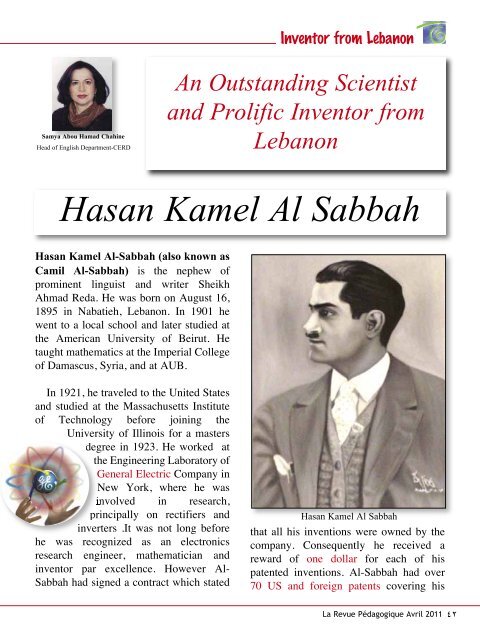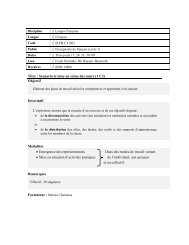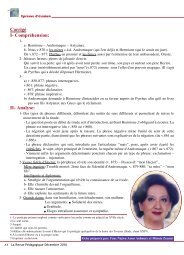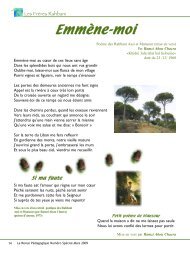Hasan Kamel Al Sabbah - CRDP
Hasan Kamel Al Sabbah - CRDP
Hasan Kamel Al Sabbah - CRDP
Create successful ePaper yourself
Turn your PDF publications into a flip-book with our unique Google optimized e-Paper software.
Samya Abou Hamad Chahine<br />
Head of English Department-CERD<br />
<strong>Hasan</strong> <strong>Kamel</strong> <strong>Al</strong>-<strong>Sabbah</strong> (also known as<br />
Camil <strong>Al</strong>-<strong>Sabbah</strong>) is the nephew of<br />
prominent linguist and writer Sheikh<br />
Ahmad Reda. He was born on August 16,<br />
1895 in Nabatieh, Lebanon. In 1901 he<br />
went to a local school and later studied at<br />
the American University of Beirut. He<br />
taught mathematics at the Imperial College<br />
of Damascus, Syria, and at AUB.<br />
In 1921, he traveled to the United States<br />
and studied at the Massachusetts Institute<br />
of Technology before joining the<br />
University of Illinois for a masters<br />
degree in 1923. He worked at<br />
the Engineering Laboratory of<br />
General Electric Company in<br />
New York, where he was<br />
involved in research,<br />
principally on rectifiers and<br />
inverters .It was not long before<br />
he was recognized as an electronics<br />
research engineer, mathematician and<br />
inventor par excellence. However <strong>Al</strong>-<br />
<strong>Sabbah</strong> had signed a contract which stated<br />
Inventor from Lebanon<br />
An Outstanding Scientist<br />
and Prolific Inventor from<br />
Lebanon<br />
<strong>Hasan</strong> <strong>Kamel</strong> <strong>Al</strong> <strong>Sabbah</strong><br />
<strong>Hasan</strong> <strong>Kamel</strong> <strong>Al</strong> <strong>Sabbah</strong><br />
that all his inventions were owned by the<br />
company. Consequently he received a<br />
reward of one dollar for each of his<br />
patented inventions. <strong>Al</strong>-<strong>Sabbah</strong> had over<br />
70 US and foreign patents covering his<br />
La Revue Pédagogique Avril 2011<br />
42
work. He was engaged in work on<br />
television and motors as well, and<br />
originated circuits for use with rectifiers.<br />
He wrote a series of articles on polyphase<br />
polycyclic static converters which were<br />
published in the General Electric Review<br />
and presented a paper on the effect of<br />
circuits on arc backs to the Mercury<br />
Congress at Paris in 1932. He was also on<br />
the fellowship list of the Institute of<br />
Electrical and Electronics Engineers. His<br />
inventions in electricity had a great impact<br />
on the development of 20th Century<br />
technology.<br />
<strong>Al</strong>-<strong>Sabbah</strong>’s dream was to build sunpowered<br />
cells in the Arabian Desert. The<br />
main ingredients for solar power are the<br />
ubiquitous sand which is used to make<br />
solar cells and the strong sun for powering<br />
them. In 1935, he declared that he would<br />
return to the Middle East and transform the<br />
Arabian Desert into a paradise. He<br />
intended to use the desert to generate and<br />
power the solar cells thus producing<br />
enormous amounts of energy.<br />
<strong>Al</strong>-<strong>Sabbah</strong>'s inventions and patents have<br />
contributed to applied technology in North<br />
America and the entire world. His patents<br />
in highly intricate systems, instruments and<br />
equipment are classified over six main<br />
categories as follows:<br />
1-Space Industry (The Solar Power)<br />
27 patents awarded between 1928 and<br />
1935. These are widely used for space as a<br />
main source of power for vehicles and<br />
satellites. The original solar cell which was<br />
invented and tested by <strong>Al</strong>-<strong>Sabbah</strong> was<br />
41 La Revue Pédagogique Avril 2011<br />
further developed after World War II by<br />
Bell Telephone Laboratories in 1955. A<br />
careful review of aircraft, spaceship, and<br />
satellite electric systems reveal that many<br />
electronic instruments and equipments<br />
such as integrators, regulators, inverters,<br />
timers, transmitters, and sensors were<br />
developed from his original inventions of<br />
rectifiers and converters.<br />
2-Automotive Industry (The Solar<br />
Electric Car)<br />
There are five basic patents (1929-35)<br />
on electric distribution, transforming and<br />
translating circuits. In 1930, he performed<br />
experiments on his own car to electrify it.<br />
He worked to make the idea of the electric<br />
car a useful and practical possibility. His<br />
early experiments gave GE the unique<br />
position as a pioneer in developing the<br />
solar cell and sodium-sulphur battery as<br />
well.<br />
3-Television and Cathode Ray Tube<br />
Application<br />
There are three patents on televisiontransmission<br />
of pictures and views (1928-<br />
30) and two patents on cathode ray tube<br />
(1935). GE research engineers developed<br />
the liquid crystal display (LCD) instrument<br />
system based on <strong>Al</strong>- <strong>Sabbah</strong>'s original<br />
patents. It is a panel for aircrafts and<br />
presents information in color, with twice<br />
the sharpness of a home TV screen. The<br />
display owes its high resolution to the large<br />
number of pixels<br />
that are activated<br />
to form an image<br />
on its screen.<br />
LCD images are<br />
normally black
and green filters. Further development and<br />
modifications of <strong>Al</strong>-<strong>Sabbah</strong>'s cathode ray<br />
tube formulated new types of CRT used in<br />
electronic systems. The television<br />
could not have been further<br />
developed without these.<br />
4-Power Generating Station<br />
It is important to note that six<br />
patents (1929-35) covered<br />
Rectifying and Rectifier<br />
Compounding systems. Another<br />
24 patents (1930-30) dealt with<br />
electric power conversion and<br />
excitation systems. He<br />
established in the early thirties<br />
the basic techniques for many applicable<br />
procedures for the protection of the<br />
excitation transformers over current and<br />
rotor over voltage/load. After his death he<br />
left a great technical legacy of useful<br />
methods, procedures and formulas. GE<br />
engineers recently developed several<br />
electronic equipments based on the original<br />
patents of <strong>Hasan</strong> <strong>Kamel</strong> <strong>Al</strong>-<strong>Sabbah</strong>.<br />
Among the new devices are the metaloxide<br />
semiconductor field-effect transistor<br />
(MOSFET), the conductivity modulated<br />
field-effect transistor (COMFET), the<br />
high-power bipolar junction transistor<br />
(HPBJT), the power MOS-controlled<br />
thyristor (PMOSCT) and the HVDC<br />
thyristor valves.<br />
5-Pressure and Temperature Electric<br />
Instrumentation<br />
There are three basic patents on pressure<br />
control (1927-1930) and one patent on<br />
temperature control (1935). Many pressure<br />
and temperature devices used in the control<br />
of steam, reheat stages such as indicators,<br />
Inventor from Lebanon<br />
transmitters, switches, sensors, detectors<br />
and controllers are based on his original<br />
patents. Several major pressure and<br />
temperature electronic gauge<br />
manufacturers signed mutual<br />
agreements with GE to produce<br />
and further develop his<br />
inventions.<br />
6-Heavy Industry: Development<br />
of New Arc Welding Methods<br />
There are basic patents on<br />
vapor electric arc (1928-1930), in<br />
addition to the six patents on<br />
rectifying and rectifiers (1928-<br />
35). These inventions are the<br />
cornerstone of the arc-welding machines<br />
and were introduced to the market in 1930.<br />
Heavy industry, ships, submarines, tanks<br />
and turbo-generators could not progress<br />
without the development of the new arc<br />
welding machinery. In the early years of<br />
the Second World War, many welding<br />
machine manufacturers further developed<br />
the welding machine to meet the military<br />
industry requirements by using the<br />
rectifying system of <strong>Hasan</strong> <strong>Kamel</strong> <strong>Al</strong>-<br />
<strong>Sabbah</strong>.<br />
<strong>Al</strong>-<strong>Sabbah</strong> died in 1935, in an<br />
automobile accident at Lewis near<br />
Elizabeth Town, New York. Mr. C.G.<br />
Marcy, the personnel director of General<br />
Electric Company, used these words to<br />
describe <strong>Hasan</strong> <strong>Kamel</strong> <strong>Al</strong>-<strong>Sabbah</strong> in a<br />
letter dated April 16, 1935.<br />
"It is indeed unfortunate that his genius<br />
mind should be brought to such an<br />
untimely end. His death is a great loss for<br />
the world of invention" n<br />
La Revue Pédagogique Avril 2011<br />
40





